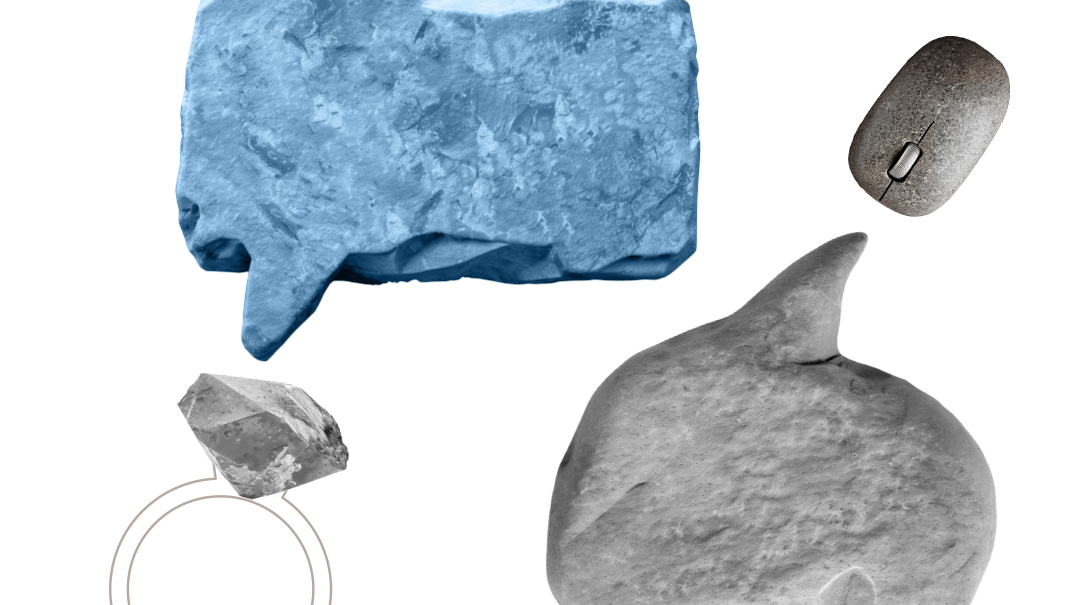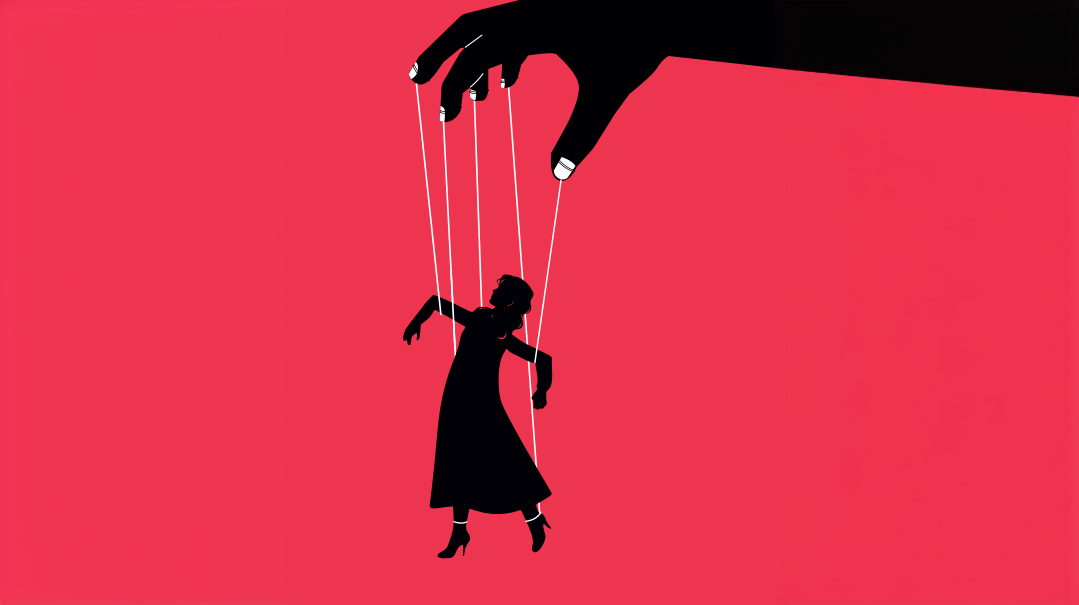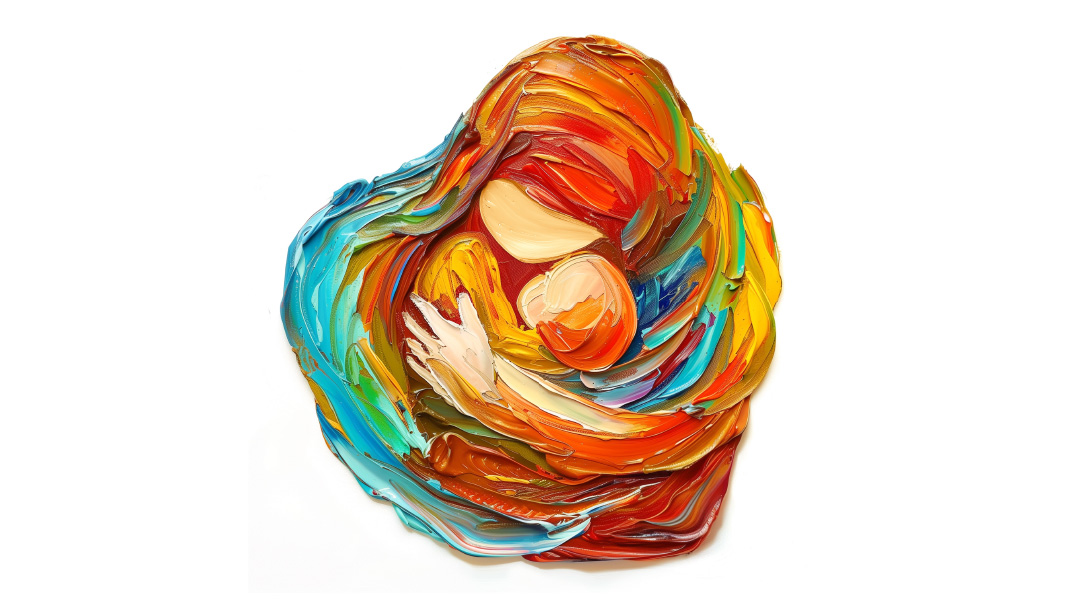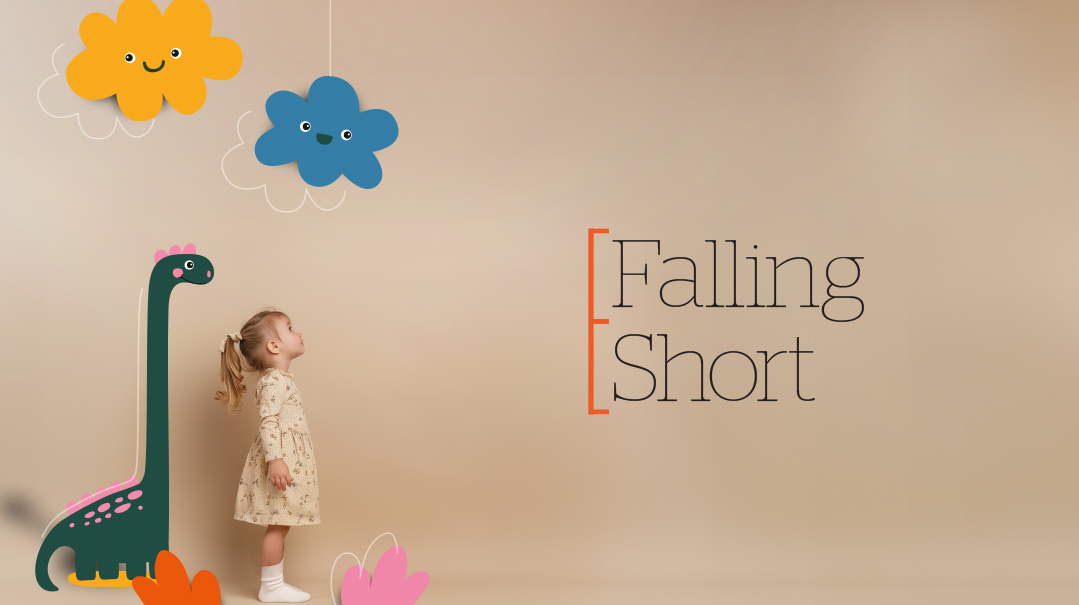Now and Then
| April 16, 2024How frum industry and fashion have evolved
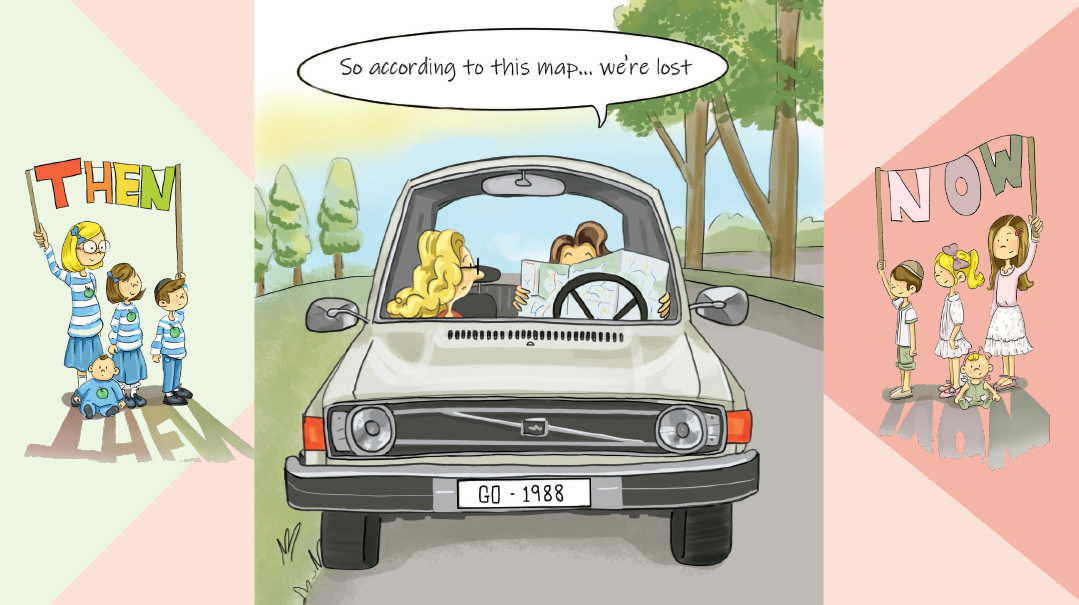
Illustrated by Michal Goren
I like to think of myself as a young mother. I mean, hey, I’m not that much older than my kids. Yet when they refer to my childhood as “the olden days,” I’ve come to realize just how different it was. Our homes, summer homes, and lives were so different. When my mother got lost, she pulled out a map. As a kid, I called my mother from a pay phone. Sometimes, when I encounter objects or places that transport me back in time, it creates a longing to go back to those simpler days.
I once took my children to Murry’s Kosher Sox in South Fallsburg. I told Mr. Murray Goldwag, the legendary owner, that I love his store because a piece of my childhood remained intact. He smiled and said that everything is exactly the same besides his back.
While we can’t go back in time, we can take a trip down memory lane to reminisce about the good ol’ days, and see just how rapidly the trends have shifted in the last three decades.
When reading the pieces note how many of the proprietors mention how social media has intensified and pressurized consumersim. It makes you wonder: Is it all worth it?
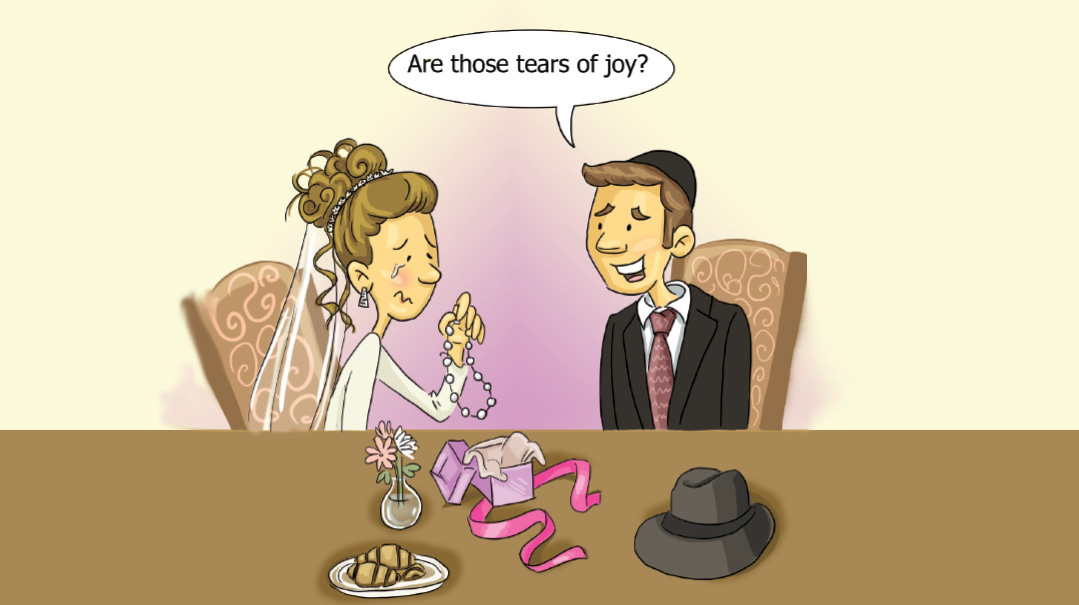
Industry
Women’s Jewelry
Name
Rivky Abecsis, Jewelry by Rivky
The way it was…
Jewelry was simpler, chunkier, with a lot of shapes — round, oval, square. Colored stones were in style, and there was so much less variety to choose from.
Kallah jewelry has changed enormously! Several decades ago kallahs received gold bracelets. Tri-colored gold bracelets were in style, and diamond bracelets were reserved for the wealthy. Tennis bracelets for kallahs were virtually unheard of. The standard yichud room present was a pearl necklace.
Eternity bands and tennis necklaces were reserved for huge milestone anniversaries and occasions.
Today…
There is so much more variety with an artistic component. Today’s customers care a lot about designer pieces. (Going back several decades, who even heard of Van Cleef & Arpels?)
Eighty percent of kallahs receive tennis bracelets (in varying sizes, shapes, and quality of diamonds). The classic yichud room gift of pearls has been replaced by tennis bars or diamond hearts. (Layering thin necklaces has also become in style.) There still are some classy, wealthy mothers-in-law who believe that every woman should have a good set of South Sea pearls, but that’s the exception.
In recent years, many young married women are getting tennis necklaces and eternity bands within four or five years of marriage (sometimes as quickly as a first anniversary!). In general, the attitude has shifted to, “It’s a special occasion, of course I’m getting something.” Receiving a piece of real jewelry is not as significant and meaningful as it used to be.
As for the explosion of the costume jewelry, funky pieces, and fake tennis bracelets? True, everything can be copied and there are some great copies out there. But gold and diamonds are still king; enough people will always want the real thing.
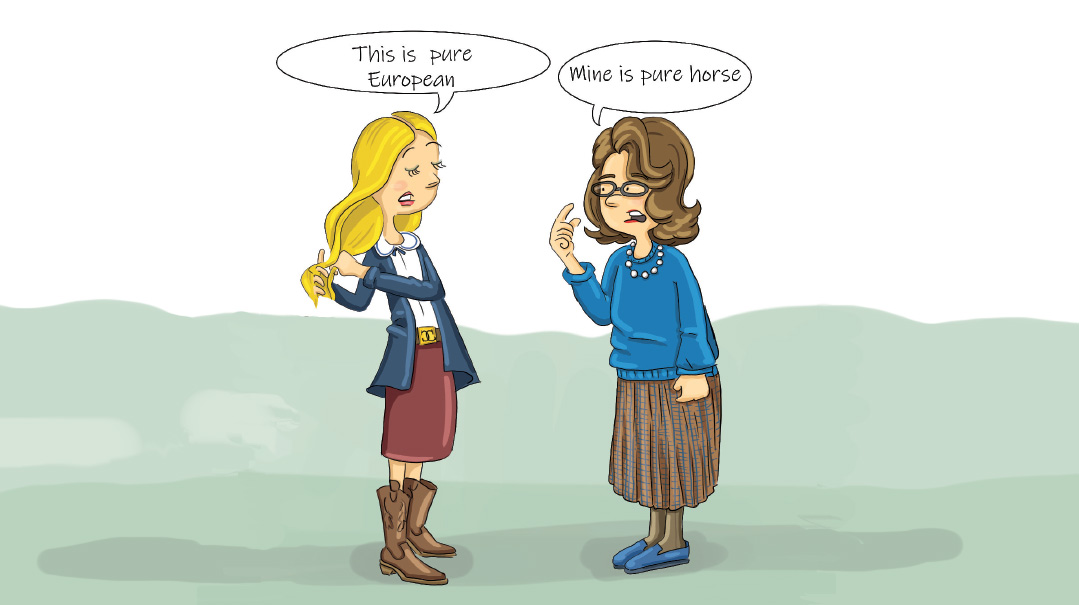
Industry
Sheitels
Name
Tziporah Ehrman, Wigs by Tziporah
The way it was…
The industry was a lot simpler. Many sheitelmachers were mommies who styled sheitels at night in a spare bedroom. It was a one-man show, with the sheitelmacher washing and setting all of the wigs. Even selling sheitels was a fairly simple process: The customer would choose a wig and the sheitelmacher would cut it. That was it. Women wore their sheitels for longer, for at least five to seven years.
Sheitels were big, with height and curls. There were side bangs, and the look was thick and top heavy. The general look was very sheitely, and teased.
Today…
The industry has become so phenomenally different! Some large companies like Shevy came onto the scene with salons, and some bold sheitelmachers took the step of moving out of the spare bedroom and into a salon or storefront.
It’s no longer about choosing a wig and cutting it. When choosing a sheitel, women look for a specific fit, hair texture, color, and hairline. There are so many specifications that it has become impossible for one person to do everything! The sheitelmachers who are working with large customer bases have several employees. They also outsource the coloring and repairs.
Styles are changing rapidly — and with social media everyone is aware of these changes. Turnaround is quicker and there is more pressure to look up-to-date. Many women feel the need to buy wigs every two to four years.
Kallahs used to get two sheitels: one for Shabbos and one for weekdays. Today’s kallahs want a casual sheitel, too, either a pony-wig or a fall.
Styles have also changed drastically over the years: It’s no longer the teased sheitely look. Today’s sheitels are sleek, natural, and gorgeous.
Because prices have gone up so much, clients want perfection. This has made it harder for the sheitelmachers, turning the industry into a very serious business. Social media and sheitel ads have contributed to the hype around the search for the perfect sheitel.
So we know sheitels are expensive, and sometimes the customer is disappointed they aren’t perfect. But please remember that we try our hardest every day to make you feel and look beautiful. It’s hard work but we live it and love it!
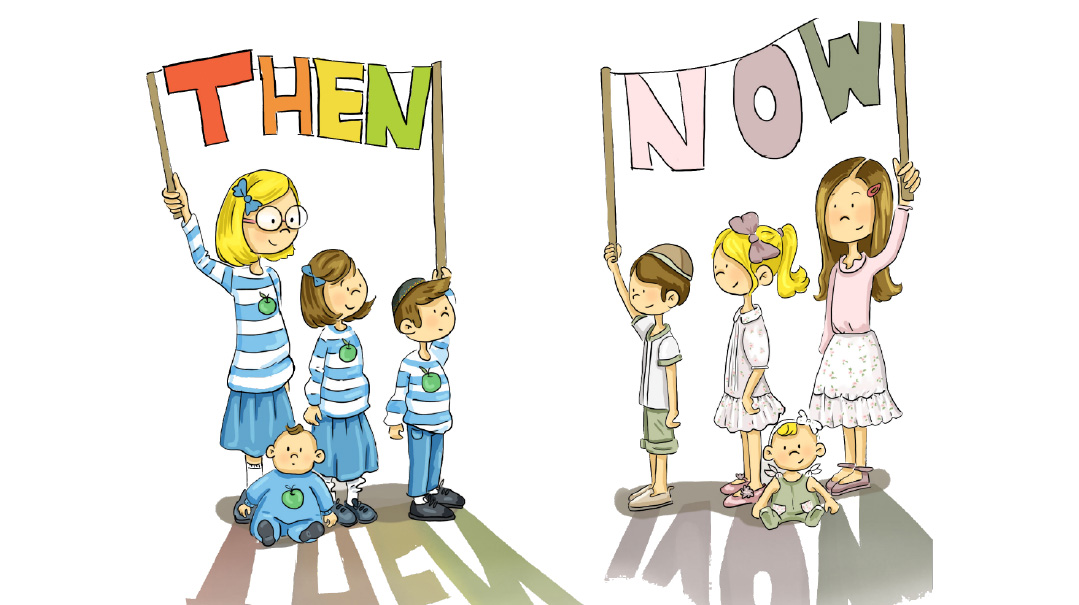
Industry
Kids’ Clothing
Name
Mrs. Bruchy Weiser, Prince and Princess
The way it was…
Shopping for children was a much simpler experience. Mothers would walk into a store, pick up a dress, and if it was cute and nice they would buy it. They didn’t think much and they didn’t care about the company name. There weren’t many trends. Everyone wanted their kids to look nice, but they didn’t care that much.
Certain classic companies, such as Petit Bateau, were very popular. While some customers still do appreciate these companies, many prefer the newer, trendier ones. Certain old-time companies that were around for many decades have gone out of business, only to be replaced by five-year-old companies that have become household names.
Today…
Today there’s less of a difference between the way that various social classes dress their children. For some, shopping for children has turned into a race. It’s all about the trends. Customers want to know what style and companies are trending. Every era has its own companies in the spotlight. Because of social media, customers are always on their toes. Many know what’s coming before we do.
Name
Rivky Hollander
The way it was…
The styles have gone through cycles. Twenty to 30 years ago, styles were more traditional. Fabric was important. Plaids, embroidery, chunky sweaters, knits, and pleated jumpers were in style.
Then we went through the hip-hop, trendy, fashion-forward styles that were long and flowy, with bright colors.
Today…
Now we’re going backward with the classic looks taking center stage once again. Kids are wearing plaids, jackets, wools, Peter Pan collars, and plaid pants with laced shoes. It’s the old-fashioned look — but of course with new twists!
Shopping has turned into a hobby and an outlet for many moms. Stores used to be cramped; today’s stores are gorgeous and boutique-like. While online has become a big thing, stores are still doing well. In the store, you get the personal shopper experience, and of course, you can touch and feel the clothing.
Many women view shopping for their children as their retail therapy. These women are like kids in candy stores! It’s a happy environment with positive vibes. Of course, for some women it is stressful — whether because of the finances or the pressure of the rat-race mentality.
Today people spend a lot more on their kids’ clothing, and prices have gone up. And everyone — no matter what social class they belong to — feels the need to dress their children nicely.
Matching was always in, but now it’s more about coordination. The ten-year-old girl isn’t matching her two-year-old brother. The companies are making coordinated pieces, so that everything is not as matchy-matchy as it used to be.
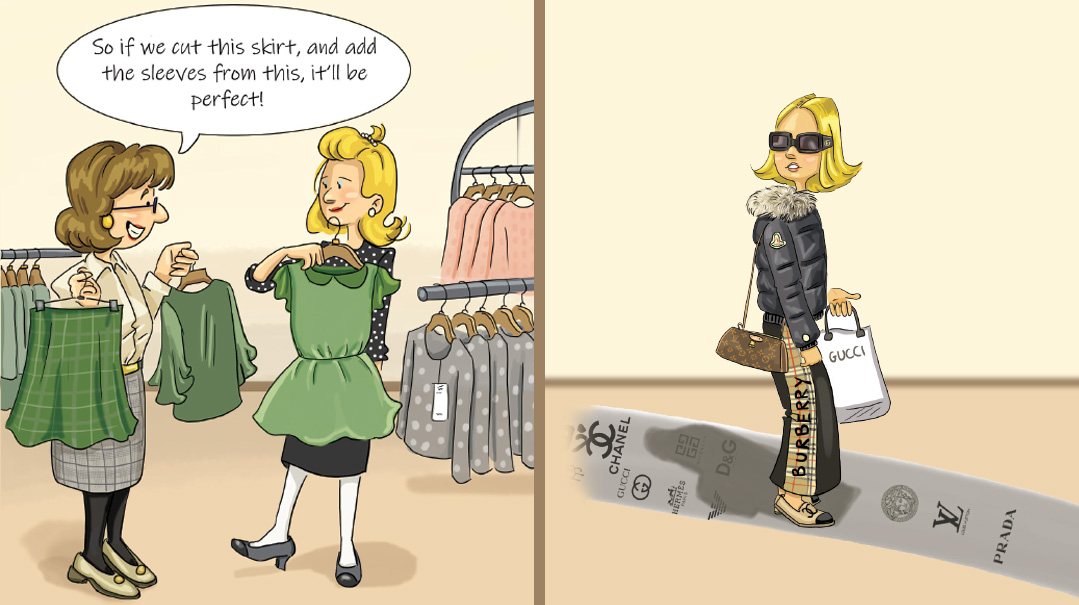
Industry
Women’s Fashion and Accessories
Name
Lisa Mendlowitz, Brenda’s
The way it was…
Every 20 to 30 years, styles repeat themselves, but it’s always with a different twist. Going back about 25 years, suits were in style. Although blazers have made a comeback, the proper two-piece fitted suits will never come back in style.
Over the past three decades, the styles have shifted from florals and colors to black…. Now we’re back to the florals and colors again. There used to be very specific styles each season with dramatic changes. One season it was midi skirts, another season was long skirts or bubble-dresses.
People have always been into brand names, but they were more discreet about it and didn’t flash around the logos. And designer labels were reserved for the super wealthy.
Twenty-five to 30 years ago, there were fewer stores and no Internet or social media. Shopping for the new season was slower-paced. Women shopped in the old mom-and-pop stores, where everyone knew each other and had personal connections with the owners. Customers were very loyal. Walking into a store with a shopping bag from another store was a big no-no.
There were no frum companies, so dressing modestly was trickier. People wore shells to compensate for problematic necklines and sleeve length. They did a lot of alterations, sometimes purchasing two dresses to combine them into one modest dress. (Today that’s almost unheard of!)
Many customers appreciated quality over quantity, purchasing several classic and timeless pieces over a myriad of trendy one-season pieces.
Today…
There is so much variety for the frum woman; the choice is astonishing. In the past ten to 15 years there has been an explosion of frum companies. Some of these companies were created by young and very talented women who have their pulse on exactly what frum women want to wear and how they want to wear it. Suits will never make a comeback, but mixing and matching blazers in varying styles is in vogue.
While fashions used to be fixed (midi/maxi/short/bubble), today everything goes. Styles are not as defined.
Brand names have also become much more of a thing and the peer pressure has become intense. It used to be the wealthy wearing designer labels; everyone else was fine with the regular companies. Today, no one wants to feel different and left out. The logos on the designer items are more significantly displayed, with the Chanel Cs on the shoes and the Dior logos on the belts.
Designer outerwear has also become popular with Moncler, Mackage, and Moose Knuckles becoming commonplace, even among high-school girls! Someone started the trend, someone else liked it, and the rest is history. As for the high-school girl walking around in a thousand-dollar winter coat? Just hope that she doesn’t lose it on the bus!
While there used to be a strong personal connection in the old-time stores, with the owners knowing all customers by name and providing old-school service, that strong loyalty doesn’t exist as much.
Over the last ten to 15 years, social media has shaken things up, and it’s only getting hotter. Frum companies have begun posting pictures with models wearing their clothing so that women can stay on top of the latest trends. Bloggers and influencers set trends, creating a certain frenzy of needing and wanting things. And with a few clicks, anyone can order whatever they want from anywhere.
What else? The turnover in women’s wardrobes is so much faster, with a focus on quantity over quality. Women don’t hang on to the quality pieces (such as Theory skirts, Elie Tahari, or Magaschoni sweaters) like they used to. Women used to touch the items, feel the fabric, and examine the quality and craftsmanship of an item. Now people don’t really care; they just want to look trendy and stylish.
Another interesting trend is the way women dress down! In certain areas it isn’t uncommon to see women sitting in a café in sportswear.
Shopping venues have changed so much. Twenty to 30 years ago, high-school girls would hit the mall during vacation to scout for some great modest finds. Today’s teens find the malls nerdy. Instead, they shop in the myriad frum, gorgeous, lavish clothing stores where shopping is an “experience.” Some stores even provide refreshments! While online shopping has become popular, in the frum world, the brick-and-mortar stores are still doing very well.
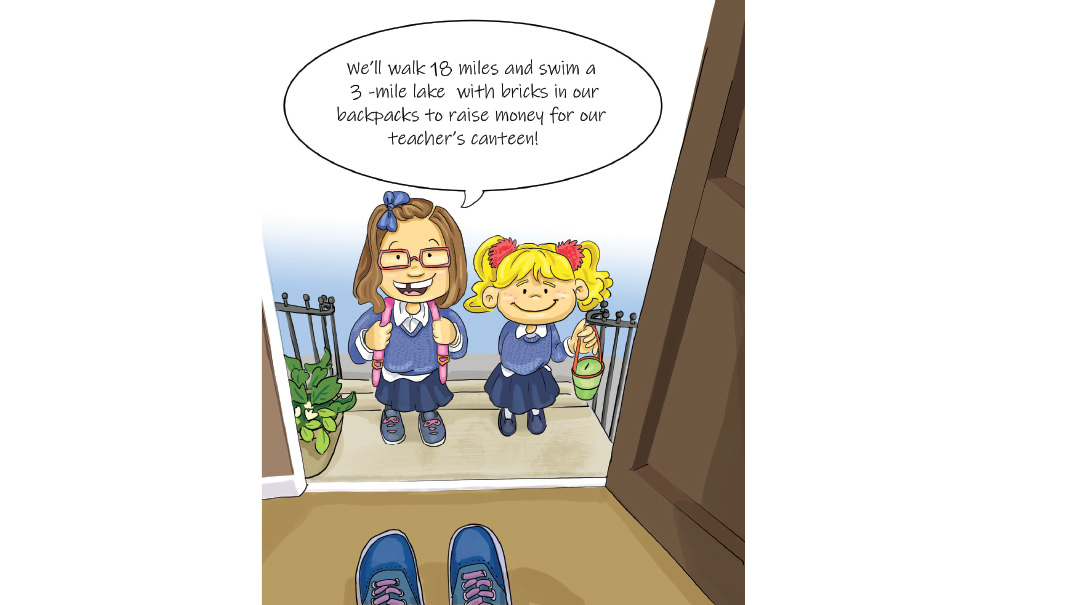
Industry
Fundraising and Events
Name
Shmuli Rosenberg, CEO fwdNYC
The way it was…
Several decades ago, there were fewer mosdos, fewer events, and fewer simchahs, and dinners were the primary source of fundraising for many mosdos. Over the years, organizations fleshed out their fundraising efforts with Chinese auctions, bake sales, teas, and parlor meetings.
A dinner was a nice night out, a social event that people got dressed up for. They’d come home with a dinner journal and enjoy reading through it.
Menus were simpler. Prime rib at a dinner was very exciting. The video presentations were primitive and it was almost unheard of to bring in big-name singers, speakers, and bands. There was an expectation that certain people had to speak — such as the chairman of the board and the honorees.
Today…
The amount of tzedakah being raised is astonishing; we’re talking hundreds of millions of dollars! Klal Yisrael has always wanted to give, but the way they give is based on current trends. It’s not that what we’re doing now makes more sense necessarily; it’s just what the current culture is.
The change in fundraising and events shifted slowly over the years. Mosdos came up with creative innovations and others borrowed the ideas until they became standard.
Dinners have changed drastically. Prime rib is no longer exciting. (People are perfectly happy to go out to a restaurant and order their own prime rib.) While the structure of the dinner used to be rigid (a reception buffet, followed by a sit-down meal, interspersed with a speech-heavy program), today, many dinners have buffets only followed by an entertaining program.
Many dinners don’t require minimum donations to attend, or even host honorees, because often this doesn’t affect the fundraising efforts. Over the last five years, many of the dinners have actually become celebration events of successful campaigns.
There’s a tremendous increase in the excitement of our causes and everyone wants their mosad to stand out. Organizations are upping the level of the dinners — trying to turn them into truly special events — because they want the attendees to gain excitement and connect to the causes.
The programs have become shorter and more concise, with a shift to speeches on videos, because it gives the organization more control over the length and content of the speeches. (It also presents as a more edited and polished product.)
Yeshivos have built-in parent bodies that feel obligated to attend the dinners. Community organizations want entertainment that will draw a crowd, so they constantly innovate with fresh, creative ideas. The programs tend to shift between the “positive, happy vibe” to the “slow, inspirational, moving vibe.” But one thing is certain: Organizations have become much more conscientious about the audience enjoying themselves.
Covid has also left its mark.
When I first suggested a virtual dinner, people thought I was nuts. But the virtual dinners worked. We did over 150 livestream events during Covid (with the help of equipment and technology that exploded then). People wondered if we would ever go back to traditional dinners! But post-Covid, there was a real yearning to go back to the in-person connection of live dinners. Today many organizations do a hybrid of a live event with a livestream.
In recent years, peer-to-peer charity fundraising has exploded. When it first emerged eight to ten years ago, it was often done on an emergency basis. It used to be the “junk food of fundraising.” It would fill you up for the moment but it wasn’t healthy in the long-term. It didn’t build relationships with donors.
Charity campaigns were either done for an emergency fund (e.g., the school burned down and we need money now for a matching campaign), or there was some gimmick involved (e.g., I’ll bike 20 miles to raise money).
The post-Covid shift over the last three years is amazing. Charity campaigns have become the bread and butter of many organizations, and they are done in a more sophisticated way with better donor engagement.
The idea that regular people can raise tzedakah just because (“my kids’ school needs money,” or “I took a page for this organization”), is a huge shift. It’s become standard and it’s truly incredible how Klal Yisrael raises money! The average person can easily raise one to two thousand dollars for a cause.
Big gevirim are giving and raising tzedakah. While they used to have parlor meetings to raise money from an exclusive set of acquaintances, today they send out messages and emails to all their contacts. In fact, many of the small events and parlor meetings have been replaced by larger peer-to-peer charity campaigns.
While the significant sums of these campaigns are raised from the big donors, about 20 percent of the funds come from small donations, which is amazing, because it allows everyone to be a part of the giving, even if you only have a little to give.
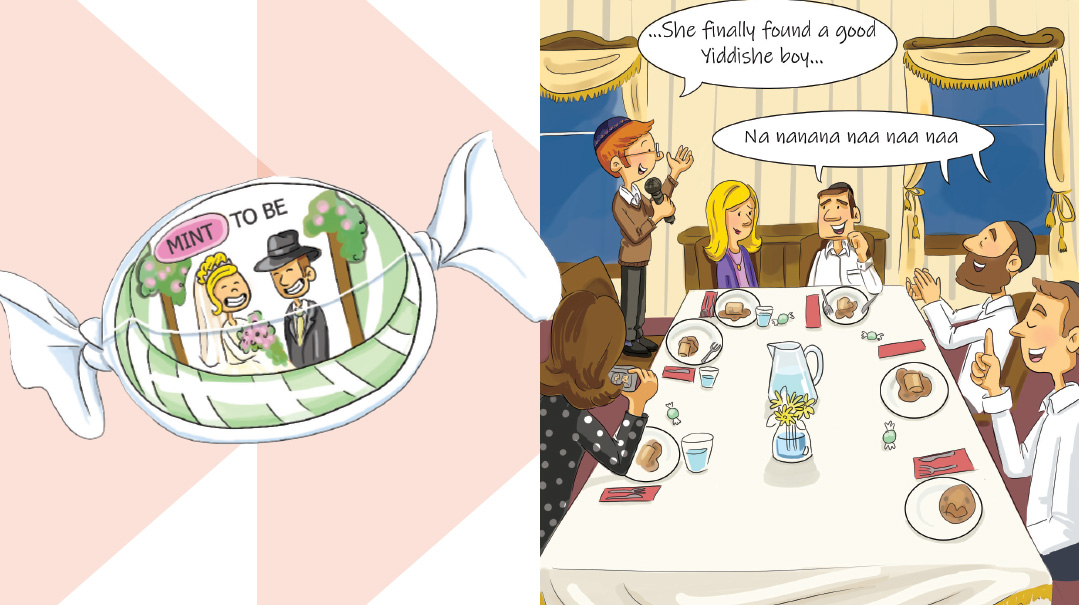
Industry
Simchahs and Party Planning
Name
Pret-a-Partee, Chavi Chase
The way it was…
It was a simpler time with little peer pressure; people spent much less on simchahs. Party planners were rare. Relatives, friends, and neighbors helped out by baking homemade cakes and cookies. (Today’s halls don’t allow this!)
Shoeboxes were tucked under the tablecloths for height and that was really fancy! Fake flowers were top notch — they were standard, and certainly nicer than no flowers! Real flowers were uncommon — only for very high-end events.
Sheva brachos were generally hosted in someone’s house with little wait staff. A few people in the kitchen helped serve the (mostly homemade) food, and that was fine because the standards of food presentation were so much lower.
All the dishes and stemware that the caterers provided were standard. No one even thought of changing it up! Napkins were nice white dinner-napkins and that was it. (Today everything is monogrammed….)
Lighting wasn’t a thing. The baal simchah walked into the hall, turned on the lights, and that was it. If you were over-the-top fancy, you would try to dim the lights a bit and set up some candles.
As for the food? Who doesn’t remember the classiest appetizer: the boureka with mushroom sauce? (Which today has been replaced by duck salad.) Molten chocolate cake with ice cream was super fancy and innovative. (Today that’s the simplest dessert for a simple sheva brachos!) Dessert tables were all homemade: Bubby would sit in her kitchen making crinkle cookies and chocolate chip cookies. And a few nice bottles of whisky on the tables was very balabatish.
Water was water. The fancy upgrade was putting the water into a pitcher. (Today people spend several dollars a bottle on fancy-looking water.)
At the really fancy sheva brochos, people went home with souvenirs such as small keychains with a picture of the chassan and kallah.
Entertainment at the simchah was grammen. If it was short, sharp, and well- done, that was the upgrade. The choir was everyone joining in with the na na na na na na nas for the chorus. (There were no celebrity singers, choirs, or magicians.)
Today…
The biggest change in the industry is the peer pressure. People feel that if they did it, now it’s standard, and I need to do it or else my child will feel deprived.
Even with all the peer pressure, there is a vast difference between simchahs these days. People are still making beautiful low-key simchahs on a budget; so many of today’s upgrades aren’t necessary.
Our simchahs have become commercialized. Using a caterer has become a given. Homey sheva brachos have been replaced by sheva brachos in restaurants. While friends and families don’t bake much for simchahs anymore, they still help out by sending cakes through the party planners. I’ve seen many siblings help out by paying for the extras and upgrades — or even for the simchahs themselves.
In the last ten years the hair and makeup industry has exploded (as have the prices). It’s also amazing how the gown gemachs have changed with the times. They’ve become so much nicer with such beautiful up-to-date selections.
While kallahs used to wear white high heels or flats, white platform sneakers have become standard for kallahs, mothers, and sisters.
Hiring “dressers” is also new to the industry, where you have someone around to help the girls put on the gowns or sew on a button that fell off the suit. And for those that don’t hire a dresser, there are even gemachs offering huge kits with anything to help with any problem that may crop up during the wedding.
Lighting became a very big thing in the simchah business, with mood lighting, up lighting, and pin spotting.
Upgrading the decor has become standard with florals, centerpieces, chargers, glassware, and cutlery in all shades and forms. The same caterer can create a unique look for all of their clients. Mixologists and bars have become very popular.
Old-fashioned grammen have been replaced with choirs and celebrity signers. Someone recently commented that she went to an incredible concert with all the celebrity singers, and what do you know? Right in the middle of the concert was a chuppah!
Choirs and singers have become common even at Shabbos simchahs. So on top of hosting your guests, you are hosting and feeding a whole choir of men! (And of course, the bigger the steak, the louder they sing.)
Baruch Hashem, there are so many simchah businesses, allowing so many to use their creativity and passion for happy occasions.
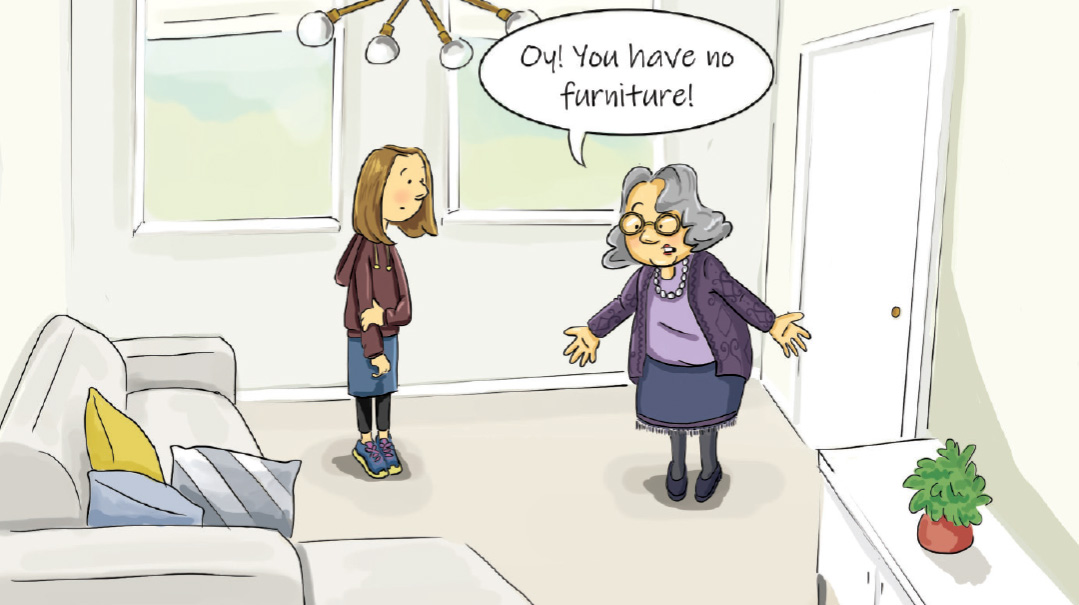
Industry
Interior Decorating
Name
Chanie Kamenetsky, CK Design
The way it was…
Twenty to 30 years ago, everything was schmaltzy and Hungarian — the doors, furniture, and upholstery. Moldings were heavily fluted. Furniture sets were considered balabatish. Who can forget the redwood mahogany furniture with ornate detail and intricate and gold inlays? (These are the dining and bedroom sets that people are trying to get rid of, without too many takers.)
There were tassels on the tassels! Tassels were everywhere, from the curtains to the linen closets. Florals couches were in style, with large, heavy pillows, and the artwork consisted of tapestry wall-hangings and needlepoints.)
Kitchen cabinets were warm wood, with ornate doors and small-tiled backsplashes, often with pictures of fruit. Counters were dark granite.
Chassan and kallah started their new home with a heavy bedroom set with twin beds (that used to be standard!). Heavy tapestry linen sets were all the rave. Balabatish couples received ornate dining room sets that they crammed into their small apartments, along with bulky seforim shranks complete with mirrors and glass shelves to proudly display their silver. (The silver was cherished! Every special occasion called for a new piece.)
Faux floral arrangements were overbearing and imposing with burgundy, green, and gold coloring.
Today…
The trends have really shifted over the last ten to 15 years. Everything has lightened up.
The lighter, simpler, more modern look has become more popular. This is great because it’s easier to maintain; it’s also easier on the eye, the floor plan, and the budget.
Dining room furniture is simpler; even the high-end Italian sets are cleaner and sleeker with lower and lighter chairs. Couches are lighter and sleeker with a lot of leather. In general, many people are opting for sleek, built-in furniture and closets as opposed to freestanding case goods. Windows, doors, and ceilings have also become much larger and higher.
Window treatments have shifted from heavy curtains with tassels to zebra shades and sheer curtains. The upside is that it’s become so much easier to furnish a house on a lower budget, especially with cheaper options and great knockoffs and copies easily available. Today’s linen is hotel-style, with high-thread-count cotton.
In kitchens, we’re seeing a lot of white and light wood. Laminates, flat panels, and acrylic cabinets are in, with white quartz countertops and backsplashes.
Our paint colors have shifted from the yellow tones to the taupe and white, with clean, straight moldings.
LED lighting has revolutionized the industry, with yellow incandescent lighting becoming obsolete.
Lucite has exploded over the last ten years, so the chunky mahogany family nameplates and bencher holders have been replaced by the sleeker Lucite ones.
While silver is still in style, the younger generation doesn’t appreciate it (and they definitely don’t enjoy polishing it). Today’s menorahs and leichters are modern and sleek. (Though the chassidim are still going with ornate styles.) China cabinets have been replaced by servers.
Popular artwork used to consist of a lot of fruits and florals. We’ve now shifted to the more Judaic and modern pieces. While there always were some random Judaica artists in Tzfas selling these pieces, today there is so much variety. People are spending real money on commissioning high-end Judaic artwork that is meaningful and personal.
(Originally featured in Family First, Issue 890)
Oops! We could not locate your form.

